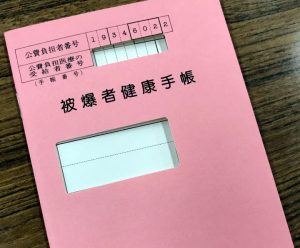Did you know? Basic information about A-bombed Hiroshima… Survivor’s certificates also issued to those who entered city after bombing, engaged in relief work
May 14, 2024
by Kana Kobayashi, Staff Writer
Effects on the human body from A-bomb radiation are not limited to the time of the detonation of the atomic bombs.
The Atomic Bomb Survivors Relief Law defines A-bomb survivors as being those who (1) directly experienced the atomic bombings in designated areas in Hiroshima and Nagasaki at the times the bombs were dropped on the cities; (2) entered an area around two kilometers of the hypocenters within two weeks after the bombings; (3) engaged in relief and aid activities, the handling of dead bodies, or became ill after being exposed to the “black rain” that fell at the time; or (4) were in the womb of mothers who experienced the atomic bombings.
For people falling under any of the four aforementioned categories, Japan’s national government issues an Atomic Bomb Survivor’s Certificate, which allows certificate holders to receive allowances and other forms of support. The certificate can be considered a form of identification proving that the holder is an A-bomb survivor. According to Japan’s Ministry of Health, Labour and Welfare, 113,649 people were holders of the certificate as of the end of March 2023.
According to Sumiko Yamada, 80, director of the A-bomb survivor consultation center of the Hiroshima Prefectural Confederation of A-bomb Sufferers Organizations (chaired by Kunihiko Sakuma), even among those eligible for the certificate, “Some hide the fact they experienced the atomic bombings out of fear of discrimination in marriage or against their offspring, or because they cannot locate witnesses necessary for their certificate application. As a result, some people are unable to receive necessary support because they do not have a certificate.”
Among A-bomb survivors are people originally from the Korean Peninsula, which was under Japanese colonial rule at the time, as well as other non-Japanese people who were in Hiroshima or Nagasaki at the time of the bombings. For a long time, A-bomb survivors living overseas, including Japanese people who had emigrated abroad after the bombings, were not provided with the same level of support as survivors who remained in Japan. That situation resulted from the fact that overseas survivors were not covered by the Atomic Bomb Survivors Relief Law. Although such survivors began to receive assistance slowly through the legal process and other means, many died before they could receive support.
Numerous other people do not fall under the aforementioned four categories, including children who were orphaned as a result of their parents being killed in the atomic bombings and parents who lost their children. What must never be forgotten is that there are many more victims of the atomic bombings besides what we commonly understand to be “A-bomb survivors.”
(Originally published on May 14, 2024)
Q: I have met people who call themselves A-bomb survivors even though they were not in Hiroshima on August 6, 1945. What is meant by this?
Effects on the human body from A-bomb radiation are not limited to the time of the detonation of the atomic bombs.
The Atomic Bomb Survivors Relief Law defines A-bomb survivors as being those who (1) directly experienced the atomic bombings in designated areas in Hiroshima and Nagasaki at the times the bombs were dropped on the cities; (2) entered an area around two kilometers of the hypocenters within two weeks after the bombings; (3) engaged in relief and aid activities, the handling of dead bodies, or became ill after being exposed to the “black rain” that fell at the time; or (4) were in the womb of mothers who experienced the atomic bombings.
For people falling under any of the four aforementioned categories, Japan’s national government issues an Atomic Bomb Survivor’s Certificate, which allows certificate holders to receive allowances and other forms of support. The certificate can be considered a form of identification proving that the holder is an A-bomb survivor. According to Japan’s Ministry of Health, Labour and Welfare, 113,649 people were holders of the certificate as of the end of March 2023.
According to Sumiko Yamada, 80, director of the A-bomb survivor consultation center of the Hiroshima Prefectural Confederation of A-bomb Sufferers Organizations (chaired by Kunihiko Sakuma), even among those eligible for the certificate, “Some hide the fact they experienced the atomic bombings out of fear of discrimination in marriage or against their offspring, or because they cannot locate witnesses necessary for their certificate application. As a result, some people are unable to receive necessary support because they do not have a certificate.”
Among A-bomb survivors are people originally from the Korean Peninsula, which was under Japanese colonial rule at the time, as well as other non-Japanese people who were in Hiroshima or Nagasaki at the time of the bombings. For a long time, A-bomb survivors living overseas, including Japanese people who had emigrated abroad after the bombings, were not provided with the same level of support as survivors who remained in Japan. That situation resulted from the fact that overseas survivors were not covered by the Atomic Bomb Survivors Relief Law. Although such survivors began to receive assistance slowly through the legal process and other means, many died before they could receive support.
Numerous other people do not fall under the aforementioned four categories, including children who were orphaned as a result of their parents being killed in the atomic bombings and parents who lost their children. What must never be forgotten is that there are many more victims of the atomic bombings besides what we commonly understand to be “A-bomb survivors.”
(Originally published on May 14, 2024)








